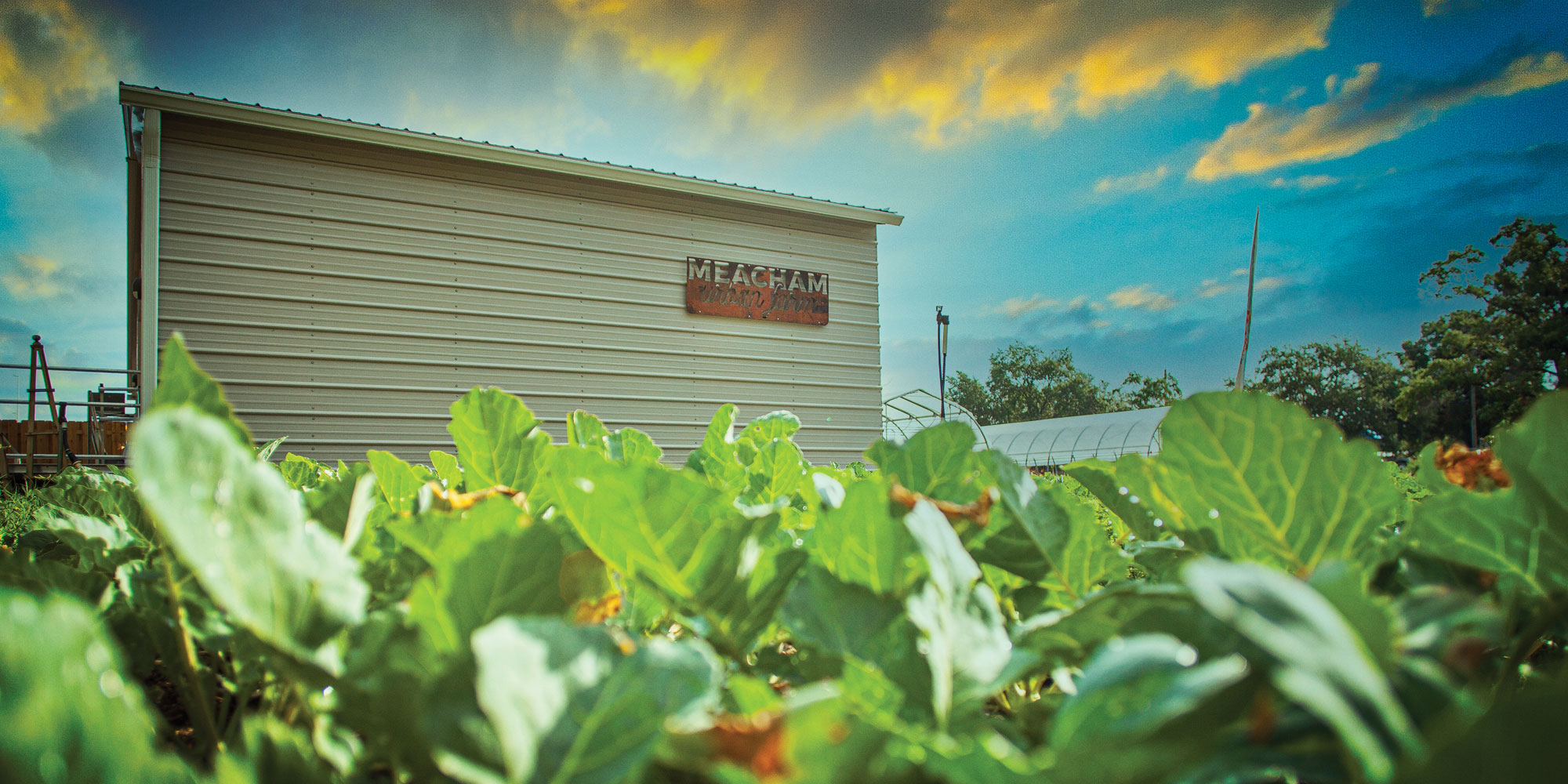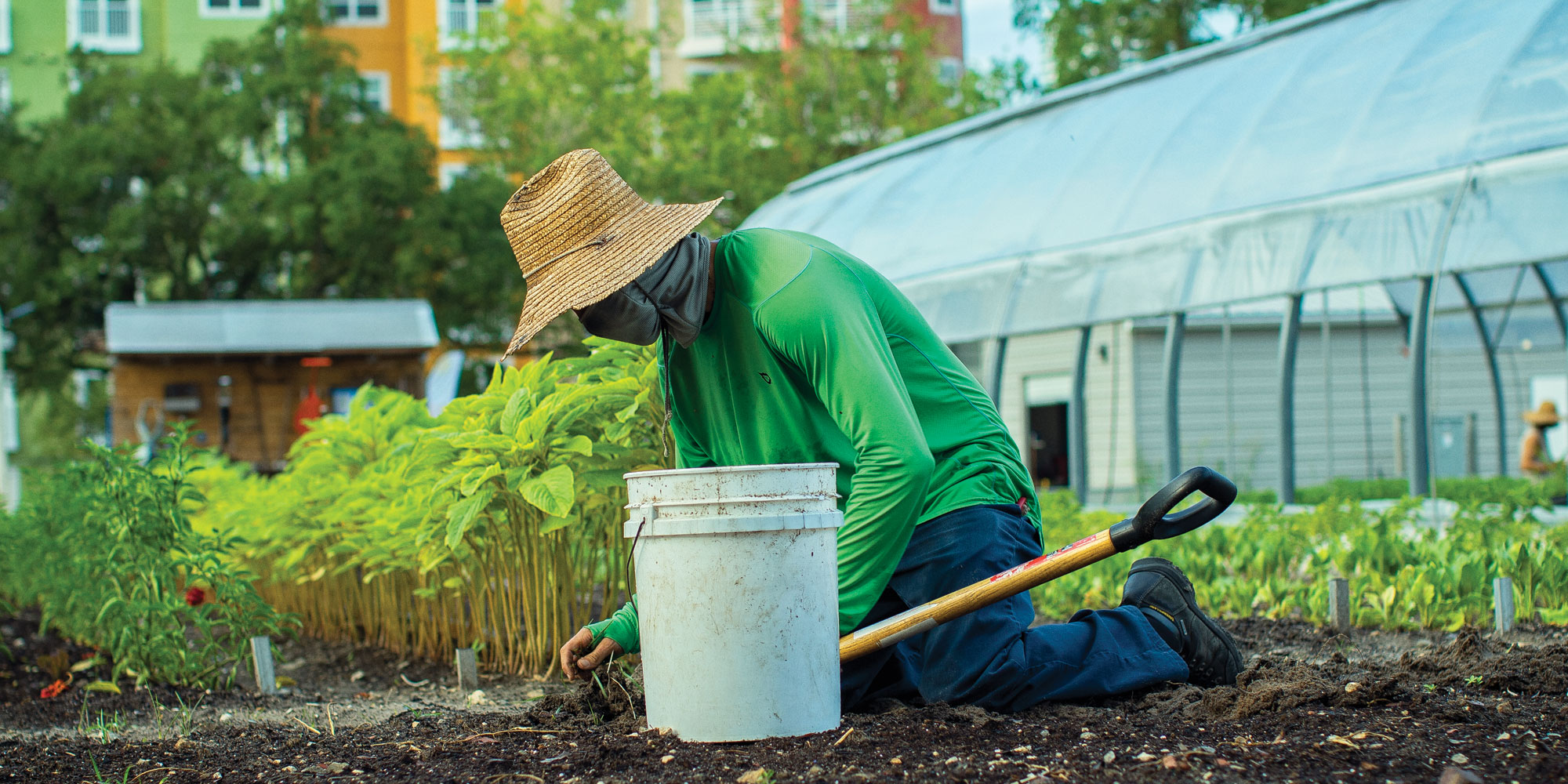At most farms, you hear nothing but the sounds of birds chirping, cows mooing and the occasional whir of light machinery.
But at Tampa’s Meacham Urban Farm, the predominant soundtrack is the whooshing of passing cars from the nearby I-275, neighbors calling to each other across the street and sirens streaking by as emergency vehicles race to their next call.

Occupying 2.1 acres of land on the northeast end of Downtown Tampa, behind the Encore housing development, Meacham is in many ways your typical farm. There are dozens of rows of lettuces, kale, carrots, onions, peppers, eggplants, beets, herbs, microgreens and even flowers. Some prefer a place directly beneath the blazing Florida sun and some take refuge from the heat and rain under one of three greenhouses. Around 30 varieties of organic vegetables and herbs grow here depending on what’s in season, alongside a coop full of 50 chickens and a honey-producing beehive.
But being in the middle of downtown means, in many other ways, Meacham is far from your typical farm. For one, perhaps unsurprisingly, the plot it sits upon was never intended to be farmland. From 1926 to 2007, it was the site of the historic Meacham school, named for Christina Meacham, the principal of Tampa’s first Black school, Harlem Academy. While the Hillsborough County School District still plans to rebuild the school when the budget and student population allows, it approved a plan to lease the land to the Tampa Housing Authority, the developer of the Encore project, for the purpose of an urban garden and market back in 2016.

According to Travis Malloy, one of the co-founders and farmers at Meacham Urban Farm, creating a farm in the middle of Downtown Tampa was a revolutionary idea, so it wasn’t easy to find someone willing to take on the project. The housing authority’s first request for proposal failed, but on the second round, they approached Malloy, who opened Temple Terrace’s TrailBale Farm with his wife, Jamie, in 2013. He took the idea to his fellow farmers (and soon-to-be Meacham co-founders) Kristin Beauvois and Joe Dalessio, who operated the small Black Finger Farm in Lutz, to develop a concept for the urban farm.
“The [Housing Authority] found us on the second round [of RFPs],” Malloy says. “They said, hey, let’s have a farm, and then Joe and Kristin and I painted the vision of what it could be. They were really happy to see that it hit all the things that they wanted to see — local food for the neighborhood and a big educational component where we can have students and neighborhood people come in and learn about urban agriculture and nutrition. It’s been a very, very cool partnership.”
The trio’s agreement with the Housing Authority was just the beginning. Dalessio says it took about two and a half years of prep work on the farm land before they began planting seeds in the summer of 2020. Growing on land not intended for agriculture took a huge learning curve, and all three pulled on their farming backgrounds. Dalessio turned his teenage passion for backyard gardening and interest in self-reliance through growing into a degree in environmental microbiology from the University of South Florida. Around graduation, he and Beauvois began working at a Tampa juice bar and bonded over their shared vision for a bigger and better local food system. Their relationship blossomed alongside the herbs and microgreens they planted in their backyard, and they eventually leased 1 acre of land in Lutz to develop Black Finger Farm, Meacham’s sister organic farm, and start selling at farmers markets around Tampa.



For Travis Malloy, community gardening in Temple Terrace led to TrailBale Farm, where he raises chickens, pigs, sheep, turkeys and other animals on pasture with organic feed. He first met Dalessio and Beauvois at the Temple Terrace Farmers Market, which he founded to connect local farmers with each other and community members. Despite the fact that agriculture is essentially his entire life now, Malloy had absolutely no interest in it as a young person.
“I started off not caring about farming at all. I grew up with punk rock and skateboarding and kept my shoes clean,” he says with a smile. “But I kind of got into it later on as just some way to give back and work on some of the Earth’s big problems.”
All three were experienced in creating something from nothing when it comes to farming, but developing an urban farm was a totally new — and unexpected — challenge.
“I think [creating an urban farm] wasn’t on the radar because we didn’t know if it was possible,” Beauvois says. “When we tell people that we have 2 acres in Downtown Tampa, they’re like, where? Because we’re so developed downtown at this point… I don’t think any of us really had our eyes set on [this area] because it didn’t really seem that accessible.”
Malloy says gardening small plots of land donated by the village of Temple Terrace inspired him to see every unoccupied corner of the city as ripe for planting. But the Meacham project quickly disabused him of that notion. Of the farm’s 2.1 acres, about half of the space is used for growing and the other half is used for support, storage and the market area. He says you’d need roughly an acre for these tasks on any farm, so any smaller piece of land would be essentially unfarmable.
“We learned so much from doing this,” he adds. “You see an empty piece of land and you think, oh yeah, let’s throw plants in there. You can’t just have plants. You need a washing station. You need a place to keep them cool. You need all these things.”
Space wasn’t the only hurdle for the Meacham team to overcome. Just like any construction in the middle of the city, they had to contend with code restrictions like setbacks, limitations on the height of their greenhouses and mandates on the amount of space between their property and buildings.
“Things are just incredibly different from typical [farm] land. You can just kind of do as you need to do on agricultural space,” Dalessio says. “This is more like downtown construction.”
They also had to rebalance the farm’s natural ecosystem, encouraging the presence of certain bugs and discouraging that of others (though that’s to be expected when starting any organic farm, Dalessio explains).
Then, most crucially, was the soil, which almost ended the Meacham project before it began.
“We’re basically on filtered sand for buildings, so it drains really well, but there’s a lot of physical rubble in it,” Dalessio says. “When we first got here, it was weeks and weeks of just picking up trash out of the ground — tons of concrete, chip bags, plastic bottles, shoes. That has been a huge challenge, something that you traditionally wouldn’t run into in agricultural land. You would go seek the prime land to farm. Here, it’s kind of like, this is what we got, and so we’ve got to make it work. We were sweating quite a bit.”
Being so close to heavy urban development also brought the potential for soil pollution.
“We went through all the soil tests and did the due diligence, but that could have just stopped the project immediately,” Malloy says.
With more than half a year of operation under their belts, the trio have mostly worked through the challenges and are fully embracing the opportunities they see the farm presenting. First and foremost is the visibility of its centralized location. To connect with the community, the farm hosts a weekend market every Saturday and Sunday with fresh produce grown on-site and at other small Florida farms to help create variety, plus bread, eggs, honey, and fresh coffee and doughnuts. As part of the grant they received from the Housing Authority, Meacham has also partnered with the school district on an education program to bring students in and teach them about agriculture, farming and where their food comes from.
“It’s fun with the different ages,” Malloy says. “Younger kids are just blown away by everything. And the older kids, you get through to them eventually. But they’re a little too cool to be wowed by a tomato or a worm or a chicken.”
All three Meacham co-owners are passionate about creating more access to fresh, local produce for everyone — from the downtown residents who can ride their bikes over or South Tampa families who are just a quick trip across I-275 to the kids in nearby V.M. Ybor or Sulphur Springs who have never seen food grow.
“Some of these kids that come over here have never picked a strawberry, and they don’t have access or time availability for someone to take them out to Plant City and do it,” Dalessio says. “So then they come out here, pull a carrot or pull some strawberries, and it’s a cool experience that the people in this community can have.”
“When I was younger, I was inspired when I went out to bakeries or Nature’s Classroom,” he adds. “We’re hoping that we can be a spot to inspire children here to maybe not be farmers, but at least have an affinity for knowing where their food comes from.”
People of all ages are also recognizing that there can be taste benefits to locally grown produce, too. In terms of flavor and freshness, you can’t beat food that’s traveled the fewest miles, Beauvois explains.
“By the time you’re getting your lettuce in the grocery store, it’s already been on a truck for probably a week, depending where they’re getting it from,” she says. “So you get a lot more longevity in the fridge [with locally grown produce]. A lot of people comment on just the differences in flavor with a few specific crops, especially carrots. [The flavor is] much different than the products that you’re getting in the grocery stores.”
“We’re working really hard to do it all in the right way,” Malloy adds. “Those chickens are free ranging. They’re out eating the grass and the bugs. The soil is built the right way. There’s no shortcuts on it. When you come here, you can see that. When people say where did you get these onions? We’re standing 20 feet from where we just picked them. We can show you what we did.”
He says having a permanent spot in perhaps the most convenient place a farm could be is a game-changer for teaching people about food and farming.
“I’ve been sitting at farmers markets for years, and still now people come in and say, well, how does this work? Well, it’s a farmers market,” he says with a laugh. “You come in and buy from farmers. It’s the awareness and the education for Florida specifically that still needs to happen. From this nice, fixed point, we can contribute to that greatly.”



